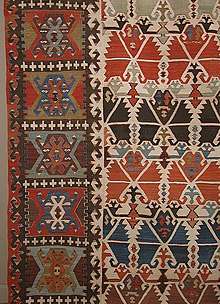Evil eye
The evil eye is a curse or legend believed to be cast by a malevolent glare, usually given to a person when one is unaware. Many cultures believe that receiving the evil eye will cause misfortune or injury,[1] while others believe it to be a kind of supernatural force that casts or reflects a malevolent gaze back-upon those who wish harm upon others (especially innocents). Talismans or amulets created to protect against the evil eye are also frequently called "evil eyes".[2][3]
The idea expressed by the term causes many different cultures to pursue protective measures against it. The concept and its significance vary widely among different cultures, but it is especially prominent in the Mediterranean and West Asia. The idea appears multiple times in Jewish rabbinic literature.[4] It was a widely extended belief among many Mediterranean and Asian tribes and cultures. Charms and decorations with eye-like symbols known as nazars, which are used to repel the evil eye, are a common sight across Cyprus, Greece, Portugal, Brazil, Israel, Georgia, Armenia, Azerbaijan, Albania, Algeria, Tunisia, Lebanon, Turkey, Palestine, Egypt, Jordan, Saudi Arabia, Bangladesh, Iran, Iraq, Italy, Nepal, Pakistan, parts of India, Morocco, southern Spain, parts of Mexico, Malta, Montenegro, Romania, Bulgaria, the Balkans, the Levant, Afghanistan, Syria, and Bahrain, and have become a popular choice of souvenir with tourists. Other popular amulets and talismans used to ward off the evil eye include the hamsa, while Italy (especially Southern Italy) employs a variety of other unique charms and gestures to defend against the evil eye, including the cornicello, the cimaruta, and the sign of the horns.
History
Belief in the evil eye dates back to Greek Classical antiquity. It is referenced by Hesiod, Callimachus, Plato, Diodorus Siculus, Theocritus, Plutarch, Heliodorus, Pliny the Elder, and Aulus Gellius. Peter Walcot's Envy and the Greeks (1978) listed more than one hundred works by these and other authors mentioning the evil eye. However, this is a westernized speculation on the origin of the evil eye. Western Asian and North African countries claim the origins of the Evil Eye originate back to Sumerian (modern day Iraq) and Egyptian roots.
Classical antiquity
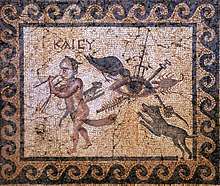
Classical authors attempted both to describe and to explain the function of the evil eye. Plutarch's scientific explanation stated that the eyes were the chief, if not sole, source of the deadly rays that were supposed to spring up like poisoned darts from the inner recesses of a person possessing the evil eye. Plutarch treated the phenomenon of the evil eye as something seemingly inexplicable that is a source of wonder and cause of incredulity.[lower-alpha 1] Pliny the Elder described the ability of certain African enchanters to have the "power of fascination with the eyes and can even kill those on whom they fix their gaze".[lower-alpha 2]
The idea of the evil eye appears in the poetry of Virgil in a conversation between the shepherds Menalcas and Damoetas.[lower-alpha 3] In the passage, Menalcas is lamenting the poor health of his stock: "What eye is it that has fascinated my tender lambs?".
Protection from the eye
The belief in the evil eye during antiquity varied across different regions and periods. The evil eye was not feared with equal intensity in every corner of the Roman Empire. There were places in which people felt more conscious of the danger of the evil eye. In Roman times, not only were individuals considered to possess the power of the evil eye but whole tribes, especially those of Pontus and Scythia, were believed to be transmitters of the evil eye.
The phallic charm called fascinum in Latin, from the verb fascinare, "to cast a spell" (the origin of the English word "fascinate") is one example of an apotropaic object used against the evil eye. They have been found throughout Europe and into the Middle East from contexts dating from the first century BC to the fourth century AD.[5] The phallic charms were often objects of personal adornment (such as pendants and finger rings), but also appeared as stone carvings on buildings,[6] mosaics, and wind-chimes (tintinnabula).[7][8] Examples of stone phallic carvings, such as from Leptis Magna, depict a disembodied phallus attacking an evil eye by ejaculating towards it.[6]
In describing their ability to deflect the Evil Eye, Ralph Merrifield described the Roman phallic charm as a "kind of lightning conductor for good luck". [9]
Around the world
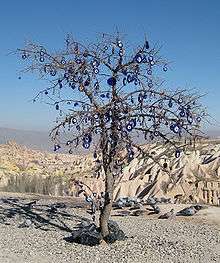
.jpg)
Belief in the evil eye is strongest in West Asia, Latin America, East and West Africa, Central America, South Asia, Central Asia, and Europe, especially the Mediterranean region; it has also spread to areas, including northern Europe, particularly in the Celtic regions, and the Americas, where it was brought by European colonists and West Asian immigrants.
Belief in the evil eye is found in the Islamic doctrine, based upon the statement of Prophet Muhammad, "The influence of an evil eye is a fact..." [Sahih Muslim, Book 26, Number 5427].[10] Authentic practices of warding off the evil eye are also commonly practiced by Muslims: rather than directly expressing appreciation of, for example, a child's beauty, it is customary to say Masha'Allah, that is, "God has willed it", or invoking God's blessings upon the object or person that is being admired.[11] A number of beliefs about the evil eye are also found in folk religion, typically revolving around the use of amulets or talismans as a means of protection.
In the Aegean Region and other areas where light-colored eyes are relatively rare, people with green eyes, and especially blue eyes, are thought to bestow the curse, intentionally or unintentionally.[12] Thus, in Greece and Turkey amulets against the evil eye take the form of blue eyes, and in the painting by John Phillip, below, we witness the culture-clash experienced by a woman who suspects that the artist's gaze implies that he is looking at her with the evil eye.
Among those who do not take the evil eye literally, either by reason of the culture in which they were raised or because they simply do not believe it, the phrase, "to give someone the evil eye" usually means simply to glare at the person in anger or disgust. The term has entered into common usage within the English language. Within the broadcasting industry it refers to when a presenter signals to the interviewee or co-presenter to stop talking due to a shortage of time.
Protective talismans and cures

Attempts to ward off the curse of the evil eye have resulted in a number of talismans in many cultures. As a class, they are called "apotropaic" (Greek for "prophylactic" / προφυλακτικός or "protective", literally: "turns away") talismans, meaning that they turn away or turn back harm.
Disks or balls, consisting of concentric blue and white circles (usually, from inside to outside, dark blue, light blue, white, and dark blue) representing an evil eye are common apotropaic talismans in West Asia, found on the prows of Mediterranean boats and elsewhere; in some forms of the folklore, the staring eyes are supposed to bend the malicious gaze back to the sorcerer.
Known as nazar (Turkish: nazar boncuğu or nazarlık), this talisman is most frequently seen in Turkey, found in or on houses and vehicles or worn as beads.
A blue or green eye can also be found on some forms of the hamsa hand, an apotropaic hand-shaped talisman against the evil eye found in West Asia. The word hamsa, also spelled khamsa and hamesh, means "five" referring to the fingers of the hand. In Jewish culture, the hamsa is called the Hand of Miriam; in some Muslim cultures, the Hand of Fatima. Though condemned as superstition by doctrinaire Muslims, it is almost exclusively among Muslims in the Near East and Mediterranean that the belief in envious looks containing destructive power or the talismanic power of a nazar to defend against them. To adherents of other faiths in the region, the nazar is an attractive decoration.
A variety of motifs to ward off the evil eye are commonly woven into tribal kilim rugs. Such motifs include a cross (Turkish: Haç) to divide the evil eye into four, a hook (Turkish: Çengel) to destroy the evil eye, or a human eye (Turkish: Göz) to avert the evil gaze. The shape of a lucky amulet (Turkish: Muska; often, a triangular package containing a sacred verse) is often woven into kilims for the same reason.[13]
Greece
The evil eye, known as μάτι (mati), "eye", as an apotropaic visual device, is known to have been a fixture in Greece dating back to at least the 6th century BC, when it commonly appeared on drinking vessels.[14] In Greece, the evil eye is cast away through the process of xematiasma (ξεμάτιασμα), whereby the "healer" silently recites a secret prayer passed over from an older relative of the opposite sex, usually a grandparent. Such prayers are revealed only under specific circumstances, as according to their customs those who reveal them indiscriminately lose their ability to cast off the evil eye. There are several regional versions of the prayer in question, a common one being: "Holy Virgin, Our Lady, if [insert name of the victim] is suffering of the evil eye, release him/her of it." Evil repeated three times. According to custom, if one is indeed afflicted with the evil eye, both victim and "healer" then start yawning profusely. The "healer" then performs the sign of the cross three times, and emits spitting-like sounds in the air three times. A very similar ritual can be found in neighboring North Macedonia and Bulgaria, as well as in Corsica.
Another "test" used to check if the evil eye was cast is that of the oil: under normal conditions, olive oil floats in water, as it is less dense than water. The test of the oil is performed by placing one drop of olive oil in a glass of water, typically holy water.[15] If the drop floats, the test concludes there is no evil eye involved. If the drop sinks, then it is asserted that the evil eye is cast indeed. Another form of the test is to place two drops of olive oil into a glass of water. If the drops remain separated, the test concludes there is no evil eye, but if they merge, there is. There is also a third form where in a plate full of water the "healer" places three or nine drops of oil. If the oil drops become larger and eventually dissolve in the water there is evil eye. If the drops remain separated from water in a form of a small circle there isn't. The first drops are the most important and the number of drops that dissolve in water indicate the strength of the evil eye.
There is another form of the "test" where the "healer" prepares a few cloves by piercing each one with a pin. Then she lights a candle and grabs a pinned clove with a pair of scissors. She then uses it to do the sign of the cross over the afflicted whilst the afflicted is asked to think of a person who may have given him the evil eye. Then the healer holds the clove over the flame. If the clove burns silently, there is no evil eye present; however, if the clove explodes or burns noisily, that means the person in the thoughts of the afflicted is the one who has cast the evil eye. As the clove explodes, the evil eye is released from the afflicted. Cloves that burn with some noise are considered to be λόγια - words - someone foul-mouthing you that you ought to be wary of. The burned cloves are extinguished into a glass of water and are later buried in the garden along with the pins as they are considered to be contaminated. Greek people will also ward off the evil eye by saying φτου να μη σε ματιάξω! which translates to "I spit so that I won't give you the evil eye." Contrary to popular belief, the evil eye is not necessarily given by someone wishing you ill, but it stems from admiration - if one considers admiration to be a compelled emotion of astonishment at a rival's success over one's evil plan. Since it is technically possible to give yourself the evil eye, it is advised to be humble.
The Greek Fathers accepted the traditional belief in the evil eye, but attributed it to the Devil and envy. In Greek theology, the evil eye or vaskania (βασκανία) is considered harmful for the one whose envy inflicts it on others as well as for the sufferer. The Greek Church has an ancient prayer against vaskania from the Megan Hieron Synekdemon (Μέγαν Ιερόν Συνέκδημον) book of prayers.
In Islam
The evil eye, or al-’ayn العين, is a common belief that individuals have the power to look at people, animals or objects to cause them harm.[16] It is tradition among many Muslims that if a compliment is to be made one should say "TabarakAllah" (تبارك الله) ("Blessings of God") or "Masha'Allah" (ما شاء الله) ("God has willed it")[17] to ward off the evil eye. Reciting Sura Ikhlas, Sura Al-Falaq and Sura Al-Nas from the Qur'an, three times after Fajr and after Maghrib is also used as a means of personal protection against the evil eye.[18]
Salafi scholars have pointed some conditions from the Quran and Hadith, which includes performing exorcism using the words of God or his names, reciting in Arabic or in language which can be understood by the people, not using any talismans or amulets or fortune-tellers or any magic, nor asking jinns to help. [19] [20][21] [22] Scholars have difference of opinion whether talismans using the Quran is permissible or not. [19]
Assyrians
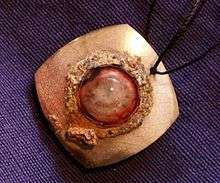
Assyrians are also strong believers in the evil eye. They will usually wear a blue/turquoise bead around a necklace to be protected from the evil eye. Also, they might pinch the buttocks, comparable to Armenians. It is said that people with green or blue eyes are more prone to the evil eye effect. A simple and instant way of protection in European Christian countries is to make the sign of the cross with your hand and point two fingers, the index finger and the middle finger, towards the supposed source of influence or supposed victim as described in the first chapter of Bram Stoker's novel Dracula published in 1897:
When we started, the crowd round the inn door, which had by this time swelled to a considerable size, all made the sign of the cross and pointed two fingers towards me. With some difficulty, I got a fellow passenger to tell me what they meant. He would not answer at first, but on learning that I was English, he explained that it was a charm or guard against the evil eye.[23]
In Judaism
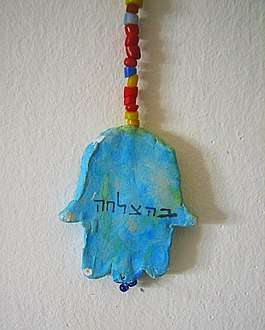
The evil eye is mentioned several times in the classic Pirkei Avot (Ethics of Our Fathers). In Chapter II, five disciples of Rabbi Yochanan ben Zakai give advice on how to follow the good path in life and avoid the bad. Rabbi Eliezer says an evil eye is worse than a bad friend, a bad neighbor, or an evil heart.
Judaism believes that a "good eye" designates an attitude of good will and kindness towards others. Someone who has this attitude in life will rejoice when his fellow man prospers; he will wish everyone well.[24] An "evil eye" denotes the opposite attitude. A man with "an evil eye" will not only feel no joy but experience actual distress when others prosper, and will rejoice when others suffer. A person of this character represents a great danger to our moral purity.[25]
Rabbi Abraham Isaac Kook explained that the evil eye is "an example of how one soul may affect another through unseen connections between them. We are all influenced by our environment.... The evil eye is the venomous impact from malignant feelings of jealousy and envy of those around us."[26]
Many Observant Jews avoid talking about valuable items they own, good luck that has come to them and, in particular, their children. If any of these are mentioned, the speaker and/or listener will say b'li ayin hara (Hebrew), meaning "without an evil eye", or kein eina hara (Yiddish; often shortened to kennahara), "no evil eye". Another way to ward off the evil eye is to spit three times (or pretend to). Romans call this custom "despuere malum," to spit at evil.[27] It has also been suggested the 10th Commandment: "Do not covet anything that belongs to your neighbor" is a law against bestowing the evil eye on another person.
Turkey
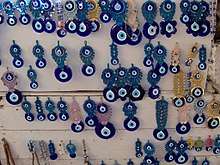
A typical nazar is made of handmade glass featuring concentric circles or teardrop shapes in dark blue, white, light blue and black, occasionally with a yellow/gold edge.[28]
Cultures that have nazars or some variation include, Turkey, Romania, Albania, Bosnia and Herzegovina, Bulgaria, Greece, Cyprus, Syria, Lebanon, Palestine, Egypt, Armenia, Iran, India, Pakistan, Uzbekistan, Afghanistan, Iraq and Azerbaijan,[29] where the nazar is often hung in homes, offices, cars, children's clothing, or incorporated in jewellery and ornaments.[28] They are a popular choice of souvenir with tourists.[30]
Ethiopia
Belief in the evil eye, or buda (var. bouda), is widespread in Ethiopia.[31] Buda is generally believed to be a power held and wielded by those in a different social group, for example among the metalworkers. Some Ethiopian Christians carry an amulet or talisman, known as a kitab, or will invoke God's name, to ward off the ill effects of buda.[32] A debtera, who is either an unordained priest or educated layperson, will create these protective amulets or talismans.[33][34]
Pakistan
In Pakistan, the evil eye is called Nazar (نظر). People usually may resort to reading the last three chapters of the Quran, namely Sura Ikhlas, Sura Al-Falaq and Sura Al-Nas. "Masha'Allah" (ما شاء الله) ("God has willed it") is commonly said to ward off the evil eye. Understanding of the evil eye varies by the level of education. Some perceive the use of black color to be useful in protecting from the evil eye. Others use "taawiz" to ward off the evil eye. Truck owners and other public transport vehicles may commonly be seen using a small black cloth on the bumpers to prevent the evil eye.[35]
Italy
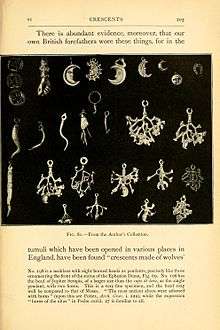
The cornicello, "little horn", also called the cornetto ("little horn", plural cornetti), is a long, gently twisted horn-shaped amulet. Cornicelli are usually carved out of red coral or made from gold or silver. The type of horn they are intended to copy is not a curled-over sheep horn or goat horn but rather like the twisted horn of an African eland or a chili pepper.[36]
One idea that the ribald suggestions made by sexual symbols distract the witch from the mental effort needed to successfully bestow the curse. Another is that since the effect of the eye was to dry up liquids, the drying of the phallus (resulting in male impotence) would be averted by seeking refuge in the moist female genitals. Among the ancient Romans and their cultural descendants in the Mediterranean nations, those who were not fortified with phallic charms had to make use of sexual gestures to avoid the eye. Such gestures include scratching one's testicles (for men), as well as the mano cornuta gesture and the fig sign; a fist with the thumb pressed between the index and middle fingers, representing the phallus within the vagina. In addition to the phallic talismans, statues of hands in these gestures, or covered with magical symbols, were carried by the Romans as talismans. In Latin America, carvings of the fist with the thumb pressed between the index and middle fingers continue to be carried as good luck charms.
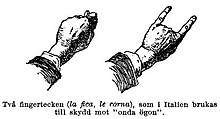
The wielder of the evil eye, the jettatore, is described as having a striking facial appearance, high arching brows with a stark stare that leaps from his black eyes. He often has a reputation for clandestine involvement with dark powers and is the object of gossip about dealings in magic and other forbidden practices. Successful men having tremendous personal magnetism quickly gain notoriety as jettatori. Pope Pius IX was dreaded for his evil eye, and a whole cycle of stories about the disasters that happened in his wake were current in Rome during the latter decades of the 19th century. Public figures of every type, from poets to gangsters, have had their specialized abilities attributed to the power of their eyes.[37]
Malta
The symbol of the eye, known as "l-għajn", is common on traditional fishing boats which are known as luzzu. They are said to protect fishermen from storms and malicious intentions.[38]
Spain and Latin America
The evil eye or 'Mal de Ojo' has been deeply embedded in Spanish popular culture throughout its history and Spain is the origin of this superstition in Latin America.
In Mexico and Central America, infants are considered at special risk for the evil eye (see mal de ojo, above) and are often given an amulet bracelet as protection, typically with an eye-like spot painted on the amulet. Another preventive measure is allowing admirers to touch the infant or child; in a similar manner, a person wearing an item of clothing that might induce envy may suggest to others that they touch it or some other way dispel envy.
One traditional cure in rural Mexico involves a curandero (folk healer) sweeping a raw chicken egg over the body of a victim to absorb the power of the person with the evil eye. The egg is later broken into a glass with water and placed under the bed of the patient near the head. Sometimes it is checked immediately because the egg appears as if it has been cooked. When this happens it means that the patient did have Mal De Ojo. Somehow the Mal De Ojo has transferred to the egg and the patient immediately gets well. (Fever, pain and diarrhea, nausea/vomiting goes away instantly) In the traditional Hispanic culture of the Southwestern United States and some parts of Mexico, the egg may be passed over the patient in a cross-shaped pattern all over the body, while reciting The Lord's Prayer. The egg is also placed in a glass with water, under the bed and near the head, sometimes it is examined right away or in the morning and if the egg looks like it has been cooked then it means that they did have Mal de Ojo and the patient will start feeling better. Sometimes if the patient starts getting ill and someone knows that they had stared at the patient, usually a child, if the person who stared goes to the child and touches them, the child's illness goes away immediately so the Mal De Ojo energy is released.[39]
In some parts of South America the act of ojear, which could be translated as to give someone the evil eye, is an involuntary act. Someone may ojear babies, animals and inanimate objects just by staring and admiring them. This may produce illness, discomfort or possibly death on babies or animals and failures on inanimate objects like cars or houses. It's a common belief that since this is an involuntary act made by people with the heavy look, the proper way of protection is by attaching a red ribbon to the animal, baby or object, in order to attract the gaze to the ribbon rather than to the object intended to be protected.[40]
Brazil
Brazilians generally will associate mal-olhado, mau-olhado ("act of giving a bad look") or olho gordo ("fat eye" i.e. "gluttonous eye") with envy or jealousy on domestic and garden plants (that, after months or years of health and beauty, will suddenly weaken, wither and die, with no apparent signs of pest, after the visitation of a certain friend or relative), attractive hair and less often economic or romantic success and family harmony.
Unlike in most cultures mal-olhado is not seen to be something that risks young babies. "Pagans" or non-baptized children are instead assumed to be at risk from bruxas (witches), that have malignant intention themselves rather than just mal-olhado. It probably reflects the Galician folktales about the meigas or Portuguese magas, (witches), as Colonial Brazil was primarily settled by Portuguese people, in numbers greater than all Europeans to settle pre-independence United States. Those bruxas are interpreted to have taken the form of moths, often very dark, that disturb children at night and take away their energy. For that reason, Christian Brazilians often have amulets in the form of crucifixes around, beside or inside beds where children sleep.
Nevertheless, older children, especially boys, that fulfill the cultural ideals of behaving extremely well (for example, having no problems whatsoever in eating well a great variety of foods, being obedient and respectful toward adults, kind, polite, studious, and demonstrating no bad blood with other children or their siblings) who unexpectedly turn into problematic adolescents or adults (for example lacking good health habits, extreme laziness or lacking motivation towards their life goals, having eating disorders, or being prone to delinquency), are said to have been victims of mal-olhado coming from parents of children whose behavior was not as admirable.
Amulets that protect against mal-olhado tend to be generally resistant, mildly to strongly toxic and dark plants in specific and strategic places of a garden or the entry to a house. Those include comigo-ninguém-pode ("against-me-nobody-cans"), Dieffenbachia (the dumbcane), espada-de-são-jorge ("St. George's sword"), Sansevieria trifasciata (the snake plant or mother-in-law's tongue) and guiné ("Guinea"), among various other names, Petiveria alliacea (the guinea henweed). For those lacking in space or wanting to "sanitize" specific places, they may all be planted together in a single sete ervas ("seven [lucky] herbs") pot, that will also include arruda (common rue), pimenteira (Capsicum annuum), manjericão (basil) and alecrim (rosemary).[41] (Though the last four ones should not be used for their common culinary purposes by humans.) Other popular amulets against evil eye include: the use of mirrors, on the outside of your home's front door, or also inside your home facing your front door; an elephant figurine with its back to the front door; and coarse salt, placed in specific places at home.[42]
Mexico
Mal de ojo (Mal: Illness - de ojo: Of eye. "To be made ill by an eye's gaze") often occurs without the dimension of envy, but insofar as envy is a part of ojo, it is a variant of this underlying sense of insecurity and relative vulnerability to powerful, hostile forces in the environment. In her study of medical attitudes in the Santa Clara Valley of California, Margaret Clark arrives at essentially the same conclusion: "Among the Spanish-speaking folk of Sal si Puedes, the patient is regarded as a passive and innocent victim of malevolent forces in his environment. These forces may be witches, evil spirits, the consequences of poverty, or virulent bacteria that invade his body. The scapegoat may be a visiting social worker who unwittingly 'cast the evil eye' ... Mexican folk concepts of disease are based in part on the notion that people can be victimized by the careless or malicious behavior of others".
Another aspect of the mal ojo syndrome in Ixtepeji is a disturbance of the hot-cold equilibrium in the victim. According to folk belief, the bad effects of an attack result from the "hot" force of the aggressor entering the child's body and throwing it out of balance. Currier has shown how the Mexican hot-cold system is an unconscious folk model of social relations upon which social anxieties are projected. According to Currier, "the nature of Mexican peasant society is such that each individual must continuously attempt to achieve a balance between two opposing social forces: the tendency toward intimacy and that toward withdrawal. [It is therefore proposed] that the individual's continuous preoccupation with achieving a balance between 'heat' and 'cold' is a way of reenacting, in symbolic terms, a fundamental activity in social relations."[43]
Puerto Rico
In Puerto Rico, Mal de Ojo or “Evil Eye” is believed to be caused when someone gives a wicked glare of jealousy to someone, usually when the person receiving the glare is unaware. The jealousy can be disguised into a positive aspect such as compliments or admiration. Mal de Ojo is considered a curse and illness. It is believed that without proper protection, bad luck, injury, and illness are expected to follow. Mal de Ojo impact is believed to affect speech, relationships, work, family and most notably, health. Since Mal de Ojo centers around envy and compliments, it creates fear of interacting with people that are outside of their culture. Indirect harm could be brought to them or their family. When it comes to children, they are considered to be more susceptible to Mal de Ojo and it is believed that it can weaken them, leading to illness. As a child grows every effort is taken to protect them. When diagnosing Mal de Ojo, it is important to notice the symptoms. Physical symptoms can include: loss of appetite, body weakness, stomach ache, insomnia, fever, nausea, eye infections, lack of energy, and temperament.
Environmental symptoms can include financial, family, and personal problems as simple as a car breaking down. It is important for those who believe to be aware of anything that has gone wrong because it may be linked to Mal de Ojo. Puerto Ricans are protected through the use of Azabache bracelets. Mal de Ojo can also be avoided by touching an infant when giving admiration. The most common practice of protection in Puerto Rico is the use of Azabache bracelets. These bracelets traditionally have a black or red coral amulet attached. The amulet is in the shape of a fist with a protruding index finger knuckle.
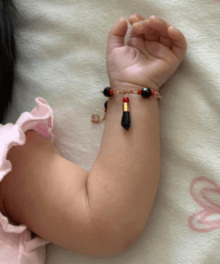
Eggs are the most common method to cure Mal De Ojo. The red string and oils also used are more common in other cultures but still used in Puerto Rico depending on the Healer, or the person who is believed to have the ability to cure those who have been targeted. Ultimately, the act of giving someone the "Evil Eye" is a rather simple process and is practiced throughout the world.
India
In the northern states of India, like the Punjab, Uttar Pradesh, Rajasthan, Haryana, Uttarakhand and Himachal Pradesh, the evil eye is called "nazar" (meaning gaze or vision) or more commonly as Buri Nazar. A charm bracelet, tattoo or other object (Nazar battu), or a slogan (Chashme Baddoor (slogan)), may be used to ward-off the evil eye. Some truck owners write the slogan to ward off the evil eye: "buri nazar wale tera muh kala" ("O evil-eyed one, may your face turn black").
In Andhra Pradesh and Telangana, people call it as 'Disti' or 'Drusti', while people of Tamil Nadu call it 'drishti' or 'kannu' (translated, means evil eye). To remove Drishti, people follow several methods based on their culture/area. Items often used are either rock salt, red chilies, white pumpkins, oiled cloth, or lemons coated with kumkuma. People remove Drishti by rotating any one of these items and around the affected person. The person who removes it will then burn the item, or discard it in a place where others are not likely to stamp on these items. People hang pictures of fierce and scary ogres in their homes or vehicles, to ward off the evil eye.[44]
In India, babies and newborn infants will usually have their eye adorned with kajal, or eyeliner. This would be black, as it is believed in India that black wards off the evil eye or any evil auras. The umbilical cord of babies is often preserved and cast into a metal pendant, and tied to a black string — babies can wear this as a chain, bracelet or belt — the belief, once more, is that this protects the infant from drishti. This is a practice that has been followed right from historical times. People usually remove drishti on full-moon or new-moon days, since these days are considered to be auspicious in India.
Indians often leave small patches of rock salt outside their homes, and hang arrangements of green chilies, neem leaves, and lemons on their stoop. The belief is that this will ward away the evil eye cast on families by detractors. [45]
United States
In 1946, the American magician Henri Gamache published a text called Terrors of the Evil Eye Exposed! (later reprinted as Protection against Evil), which offers directions to defend oneself against the evil eye.[46]
Media and press coverage
In some cultures over-complimenting is said to cast a curse. So does envy. Since ancient times such maledictions have been collectively called the evil eye. According to the book The Evil Eye by folklorist Alan Dundes,[47] the belief's premise is that an individual can cause harm simply by looking at another's person or property. However, protection is easy to come by with talismans that can be worn, carried, or hung in homes, most often incorporating the contours of a human eye. In Aegean countries, people with light-colored eyes are thought to be particularly powerful, and amulets in Greece and Turkey are usually blue orbs. Indians and Jews use charms with palm-forward hands with an eye in the center; Italians employ horns, phallic shapes meant to distract spell casters.[48]
Names in various languages
In most languages, the name translates literally into English as "bad eye", "evil eye", "evil look", or just "the Eye". Some variants on this general pattern from around the world are:
- In Albanian it is known as "syri i keq" (Standard and Tosk), or as "syni keq" (Gheg) meaning "bad eye". Also "mësysh" is used commonly, meaning "cast an evil eye".
- In Arabic, ʿayn al-ḥasūd, عين الحسود, "the eye of envy". ʿAyn ḥārrah (عين حارّة) is also used, literally translating to "hot eye".
- In Armenian, char atchk (չար աչքն) "evil eye" or "bad eye". Regarding the act of giving an evil gaze, it is said (directly translated), "to give with the eye" or in Armenian, "atchkov tal".
- In Azerbaijani, "Göz dəyməsi" – translating as being struck by an eye
- In Chinese it is called 邪惡之眼 (Traditional Chinese characters) / 邪恶之眼 (Simplified Chinese characters) (xié è zhī yǎn, literally "evil eye") or simply 邪眼 (xié yǎn).
- In Corsican it is called "l'Ochju" (The Eye).
- In Dutch it is called "het boze oog", literally "the malicious eye" or "the angry eye".
- In Esperanto, it is called "malica okulo" (malicious eye).
- In Finnish, it's called "paha silmä" (evil/bad eye)
- In French, it is named "le mauvais Œil" (The bad eye)
- In Galician, it is called "meigallo", from meiga, "witch" (and maybe -allo, diminutive or aumentative suffix; or contracted with either ollo, "eye"; or allo, "garlic").
- In German, it is called "böser Blick", literally "evil gaze".
- In Greek, to matiasma (μάτιασμα) or mati (μάτι) someone refers to the act of casting the evil eye (mati being the Greek word for eye); also: vaskania (βασκανία, the Greek word for jinx)[49]
- In Hebrew, ʿáyin hā-ráʿ (עַיִן הָרַע, "eye of evil")
- In Hindi and other languages of South Asia, (Hindi: nazar (नज़र); nazar lagna (नज़र लगना)) means to be afflicted by the evil eye. (However, it generally has no evil connotations because a doting mother's eye can supposedly also cause harm.) In Urdu, another variant of Hindustani, nazar (نظر)"Chashm-é bad"( چشمِ بد); nazar lagna means to be afflicted by the evil eye.
- In Hungarian, gonosz szem means "evil eye", but more widespread is the expression szemmelverés (lit. "beating with eye"), which refers to the supposed/alleged act of harming one by an evil look
- In Irish, the term drochshúil is used for the 'evil eye', being a compound of 'droch' (bad, poor, evil, ill) and 'súil (eye). This can also be used to refer to someone with weak eyesight.
- In Italian, the word malocchio (pronounced [maˈlɔkkjo]) refers to the evil eye.
- In Japanese it is known as "邪視" ("jashi").
- In Ke/Tz Luo, it is called "Sihoho/Juog wang'".
- In Kurdish, it is called "Çav pîs/Chaw pis/ چاو پیس"
- In Malayalam it is known as kannu veykkuka – to cast an evil eye while "kannu peduka" means to be on the receiving end of the malefic influence. "kannu dosham" refers to a bad effect caused by an evil eye.
- In Maltese it is known as "l-għajn". It is a common symbol for warding off evil intentions.
- In Neapolitan it is known as "'o mma'uocchje" which translates literally into "the evil/bad/maleficent eye", which afflicts people, especially women and children who are supposedly the most vulnerable, with multiple issues and problems, stemming from pre-natal issues, miscarriages, early childhood death or sickness or death of a mother during birth, as well as afflicting women with infertility, sexual problems, early widowhood, etc., while afflicted men suffer from cancer, laziness, greed, gluttony, and other diseases, disabilities and ailments.
- In Persian it is known as "چشم زخم" (injurious look/eyes causing injury) or "چشم شور" (omen eye)[50] "Cheshmeh Hasood", meaning Jealous eye, or "Cheshme Nazar" meaning evil eye.
- In Polish it is known as "złe oko" or "złe spojrzenie".
- In Portuguese, it is called "mau olhado", ou "olho gordo" (literally "fat eye"). The first expression is used in Portugal and the second one is more common in Brazil.
- In Romanian, it is known as "deochi", meaning literally "un-eye".
- In Russian, "дурной глаз" (durnoy glaz) means "bad/evil eye"; "сглаз" (sglaz) literally means "from eye".
- In Sanskrit, an ancient Indo-Aryan language, it is called "drishti dosha" (दृष्टि दोष) meaning malice caused by evil eye. (But cf. "drishti (yoga)".)
- In Serbo-Croatian (Serbian, Croatian, Bosnian and Montenegrin), it is called Urokljivo oko (Cyr. Урокљиво око).[51] The first word is an adjective of the word urok/урок, which means spell or curse, and the second word means eye.
- In Slovak, it is known as "z očí", meaning "(coming) from eyes".
- In Somali, it is called "il", or "ilaaco" or "sihir" (the first two words literally meaning "eye" and the other word meaning 'black magic')
- In Sinhala it is known as "ඇස්වහ" (æsvaha).
- In Spanish, mal de ojo literally means "evil from the Eye" as the name does not refer to the actual eye but to the evil that supposedly comes from it. Casting the evil eye is then echar mal de ojo, i.e. "to cast evil from the Eye".[52]
- In Tamil, "கண் படுதல்" (kan padudhal) literally means "casting an eye" (with an intention to cause harm). "கண்ணூறு" (kannooru) "harm from the eye"
- In Turkish kem göz means evil eye and the cure is having a "nazar boncuğu", the nazar amulet.
- In Welsh y llygad drwg, y llygad mall, drwglygad [53]
- In Yiddish עין הרע (ayin hora אַייִן האָראַ)
See also
Amulets and other protections
- Azabache - Spanish and Latin American amulet used to ward off the evil eye, especially in the form of a pin placed on infants
- Cornicello - Italian amulet used to ward off the evil eye
- Eye of Horus - an Ancient Egyptian symbol of protection and power against evil.
- Eyespot (mimicry) - as found in living organisms
- Hamsa - middle eastern protection amulet
- Harmal - plant used as protection against the evil eye
- Mirror armour - believed to protect not from only cold steel and arrows, but also from the evil eye
- Nazar
- Red string (Kabbalah)
- Sign of the horns - horned hand gesture used for warding off the Evil Eye and other purposes
Creatures
- Balor - a character in Irish legend
- Basilisk - Death glance/petrifying glance
- Beholder (Dungeons & Dragons) - modern invention
- Cockatrice - Death glance/petrifying glance
- Medusa and Gorgon - Petrification glance, picture also used on as protection from the evil eye.
- Petrifaction in mythology and fiction.
Concepts
- Eye of Providence - a symbol showing an eye surrounded by rays of light or a glory, and usually enclosed by a triangle.
- Lashon hara - Jewish concept of the "evil tongue"
- Matthew 6:23 "If thine eye be evil" - The evil eye as ungenerosity of spirit, hence darkness / blindness / evil itself.
- Rule of Three
- Scopophobia - fear of being stared at
- Usog - a Filipino version.
Notes
References
- Ross, C (2010). "Hypothesis:The Electrophysicological Basis of the Evil Eye Belief". Anthropology of Consciousness. 21: 47–57. doi:10.1111/j.1556-3537.2010.01020.x.
- "Definition for "evil eye" from Merriam Webster Dictionary". Merriam-webster.com. 2012-08-31.
- "evil eye (occult)". Encyclopædia Britannica.
- Ulmer, Rivka (1994). KTAV Publishing House, Inc. (ed.). The evil eye in the Bible and in rabbinic literature. p. 176. ISBN 978-0-88125-463-1.
- Whitmore, A. (2017). "Fascinating fascina: apotropaic magic and how to wear a penis". In Cifarelli, M.; Gawlinkski, L. (eds.). What shall I say of clothes? Theoretical and Methodological Approaches to the Study of Dress in Antiquity. Boston, MA: American Institute of Archaeology. pp. 47–65.
- Parker, A. (2017). "Protecting the Troops? Phallic Carvings in the North of Roman Britain". In Parker, A (ed.). Ad Vallum: Papers on the Roman Army and Frontiers in celebration of Dr Brian Dobson. BAR British Series 631. Oxford: British Archaeological Report. pp. 117–130.
- Parker, A. (2018). "The Bells! The Bells! Approaching tintinnabula in Roman Britain and Beyond". In Parker, A.; Mckie, S. (eds.). Material Approaches to Roman Magic: Occult Objects and Supernatural Substances. TRAC Themes in Roman Archaeology 2. Oxford: Oxbow. pp. 57–68.
- Johns, C. (1989). "The Phallus and the Evil Eye". Sex or Symbol? Erotic Images of Greece and Rome. London: British Museum Press.
- Merrifield, R. (1969). Roman London. London: Cassell. p. 170.
- "USC-MSA Compendium of Muslim Texts". Usc.edu. Archived from the original on 2007-09-03. Retrieved 2007-09-22.
- "Du'a – What to say when in fear of afflicting something or someone with one?s eye". Makedua.com. Archived from the original on 2007-10-06. Retrieved 2007-09-22.
- Cora Lynn Daniels, et al., eds, Encyclopædia of Superstitions, Folklore, and the Occult Sciences of the World (Volume III), p. 1273, Univ. Press of the Pacific, Honolulu, ISBN 1-4102-0916-4
- Erbek, Güran (1998). Kilim Catalogue No. 1. May Selçuk A. S. Edition=1st.
- Merriam-Webster. Merriam-Webster's Encyclopedia of World Religions. 2000, p. 69. ISBN 0877790442.
- Petropoulos, John (2008). "Ritual Word and Symbolic Movement in Spells Against the Evil Eye". Greek Magic: Ancient, Medieval and Modern. London: Routledge. pp. 107–117.
- "Evil Eye - Oxford Islamic Studies Online". www.oxfordislamicstudies.com. Retrieved 2018-08-25.
Popular belief that a person can glance or stare at someone else's favorite possession and, if envious of the other person's good fortune, hurt, damage, or destroy it.
- "Mashallah: what it means, when to say it and why you should". The National. Retrieved 2018-08-25.
- Definition of the evil eye, and ways of protecting oneself against it and treating it Archived 2012-04-16 at the Wayback Machine, Islam Questions and Answers
- https://www.kalamullah.com/Books/Selected%20Fatwas%20on%20Faith%20Healing%20and%20Witchcraft.pdf
- "Ruling on amulets and hanging them up; do amulets ward off the evil eye and hasad (envy)? - Islam Question & Answer". islamqa.info. Retrieved October 27, 2019.
- http://www.ruqyaqa.com/uploads/2/5/2/5/25255474/the_jinn_and_human_sickness.pdf
- http://www.islamtomorrow.com/books/major_sins/majorSins.pdf
- Dracula Archived 2009-05-05 at the Wayback Machine, Bram Stoker's novel 1897 edition online. p. ?
- "Evil Eye in Judaism". My Jewish Learning.
- Chapters of the Fathers, Translation & Commentary by Samson Raphael Hirsch, Feldheim Publishers, ISBN 0-87306-182-9 pg. 32
- Morrison, Chanan; Kook, Abraham Isaac Kook (2006). Gold from the Land of Israel: A New Light on the Weekly Torah Portion - From the Writings of Rabbi Abraham Isaac HaKohen Kook'. Urim Publications. p. 88. ISBN 978-965-7108-92-5.
- Joyce Eisenberg and Ellen Scolnic. "The Whole Spiel: Funny essays about digital nudniks, seder selfies and chicken soup memories," Incompra Press, ISBN 978-0-692-72625-9 pg. 153
- Lonely Planet Middle East.Lonely Planet; 6 edition, 2009, p. 559.
- Stoltz, Dustin (May 26, 2012). "The Evil Eye and Mountain Karma in Azerbaijan". www.dustinstoltz.com.
- "The History and the meaning of the Turkish Evil Eye".
- Turner, John W. "Ethiopian Orthodox Christianity: Faith and practices". A Country Study: Ethiopia. Thomas P. Ofcansky and LaVerle Berry, eds. Washington: Library of Congress Federal Research Division, 1991.
- Kemp, Charles. "Ethiopians & Eritreans. Archived 2012-12-10 at Archive.today" Refugee Health – Immigrant Health. Waco, TX: Baylor University.
- Finneran, Niall. "Ethiopian Evil Eye Belief and the Magical Symbolism of Iron Working." Folklore, Vol. 114, 2003.
- Geleta, Amsalu Tadesse. "Case Study: Demonization and the Practice of Exorcism in Ethiopian Churches Archived 2010-01-01 at the Wayback Machine". Lausanne Committee for World Evangelization, Nairobi, August 2000.
- Ghilzai, S.A., and Kanwal, A. (2016) Semiotic Analysis of Evil Eye Beliefs among Pakistani Cultures and their Predetermined Behaviour. Research Issues in social sciences, 47-67.
- Lucky Mojo. "The Corno (Italian Horn Amulet)". Retrieved 9 February 2015.
- Maloney, Clarence. The Evil Eye. New York: Columbia UP, 1976. p. 29. ISBN 0-231-04006-7.
- "A traditional seacraft gradually on the decline".
- "Medical Anthropology: Explanations of Illness". Archived from the original on 2012-08-17.
- Flórez, Franz. "El Mal de Ojo de la Etnografía Clásica y La Limpia Posmoderna" (PDF). Archived from the original (PDF) on 2011-07-27.
- Guizetti, Franco. "Conheça o poder e a proteção das sete ervas" (in Portuguese). Retrieved Jan 19, 2012.
- Caires, Olivia. "Proteja sua casa do mau olhado" (in Portuguese). Retrieved February 22, 2015.
- Maloney, Clarence. The Evil Eye. New York: Columbia UP, 1976. p. 184. ISBN 0-231-04006-7.
- Kannan, Shalini (2016). "Surprises And Superstitions In Rural Tamil Nadu".
- Amariglio, Jack; Cullenberg, Stephen E; Ruccio, David F (2013). Post-Modernism, Economics and Knowledge. Routledge. pp. 217–. ISBN 978-1-134-83668-0.
- Gamache, Henri (1946) Terrors of the Evil Eye Exposed Raymond Publishing, New York, OCLC 9989883; reprinted in 1969 as Protection Against Evil Dorene, Dallas, Texas, OCLC 39132235
- Dundes, Alan (ed.) (1992) The Evil Eye: A Casebook University of Wisconsin Press, Madison, Wisconsin, ISBN 0-299-13334-6; originally published in 1981 by Garland Publishing, New York
- Rizzo, Johnna (April 2013) National Geographic Magazine
- Vaskania (Βασκανία) in Εγκυκλοπαιδικό Λεξικό Ελευθερουδάκη, (Encyclopedic Lexicon Eleftheroudakis) ed. 1928
- loghatnaameh.com. "Dictionary of Dehkhoda – لغتنامه دهخدا". Loghatnaameh.com. Archived from the original on 2011-07-18.
- "Hakim Bey: Urokljivo oko (evil eye)". Kontrapunkt. February 7, 2006. Archived from the original on 21 July 2011. Retrieved 3 January 2011.
- "Real Academia Española de la Lengua. Diccionario Usual" (in Spanish). Buscon.rae.es.
- http://geiriadur.ac.uk/gpc/gpc.html?llygad
Further reading
- Dundes, Alan (1992). The Evil Eye: A Casebook. Madison, WI: The University of Wisconsin Press. ISBN 0-299-13334-6.
- Borthwick, E. Kerr (2001) "Socrates, Socratics, and the Word ΒΛΕΠΕΔΑΙΜΩΝ" The Classical Quarterly New Series, 51(1): pp. 297–301
- Dickie, Mathew W. (January 1991) "Heliodorus and Plutarch on the Evil Eye" Classical Philology 86(1): pp. 17–29
- Elliott, John H. (2015) Beware the Evil Eye: The Evil Eye in the Bible and the Ancient World: Volume 1: Introduction, Mesopotamia, and Egypt. Eugene, OR: Cascade.
- Elliott, John H. (2016) Beware the Evil Eye: The Evil Eye in the Bible and the Ancient World: Volume 2: Greece and Rome. Eugene, OR: Cascade.
- Elworthy, Frederick Thomas (1895) The Evil Eye. An Account of this Ancient & Widespread Superstition John Murray, London, OCLC 2079005; reprinted in 2004 as: The Evil Eye: The Classic Account of an Ancient Superstition Dover Publications, Mineola, New York, ISBN 0-486-43437-0 (online text)
- Gifford, Edward S. (1958) The Evil Eye: Studies in the Folklore of Vision Macmillan, New York, OCLC 527256
- Jones, Louis C. (1951) "The Evil Eye among European-Americans" Western Folklore 10(1): pp. 11–25
- Limberis, Vasiliki (April 1991) "The Eyes Infected by Evil: Basil of Caesarea's Homily" The Harvard Theological Review 84(2): pp. 163–184
- Lykiardopoulos, Amica (1981) "The Evil Eye: Towards an Exhaustive Study" Folklore 92(2): pp. 221–230
- Meerloo, Joost Abraham Maurits (1971) Intuition and the Evil Eye: The Natural History of a Superstition Servire, Wassenaar, Netherlands, OCLC 415660
- Shamash, Jack (2020) 'The Evil Eye - The Magic of Envy and Destruction' Foxy Books, London ISBN 978-1-5272-5860-0
- Slone, Kathleen Warner and Dickie, M.W. (1993) "A Knidian Phallic Vase from Corinth" Hesperia 62(4): pp. 483–505
- Mal de ojo
External links
| Look up evil eye in Wiktionary, the free dictionary. |
| Wikisource has the text of the 1911 Encyclopædia Britannica article Evil Eye. |
![]()
